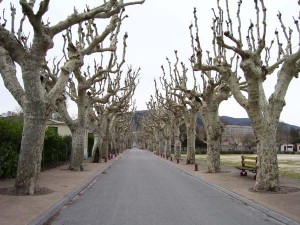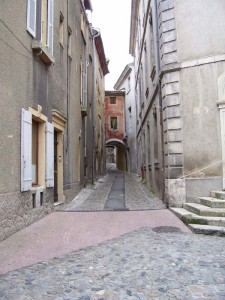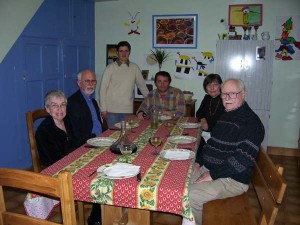THE RIVERS OF FRANCE – NORTH ON THE RHONE
THE RIVERS OF FRANCE
This is the fifth in a series of articles about a boat trip along the Rhone River.
By Charles N. Stevens
Photos by Dolores Seidman
After one full day in Avignon and another in Arles, we finally begin our journey north up the Rhone River. Darkness still shrouds Avignon as our small ship leaves early in the morning, yellowish light illuminating the city walls, the Papal Palace and especially the golden statue of Mary atop the cathedral.
As our ship cruises northward dawn begins to break in the east, the still-hidden sun touching scattered clouds on the horizon with pink and gold. Wildlife is also astir, the swift silhouettes of ducks flying north cutting across the morning sky. Gulls ply the river and a cormorant flies so low that its wingtips touch the water. Long-necked swans hug the shore.
Part of river travel is passing through locks, the first one, the highest I have ever seen, will lift us seventy five feet. It works efficiently, and we rise to the next level in only a few minutes. We pass a small town in which all of the houses and buildings are exactly the same shade of brown. Perhaps there is a building code that requires it.
Our first stop is at the town of Viviers. From one angle we can see the town and from another the large beige scars of a nearby rock quarry. We walk into town on a road lined with trimmed and naked plane trees, their trunks thick and mottled gray and white, their crowns branching out like thick gnarled fingers. The water levels of past floods are marked on the first building we approach. Towns along rivers everywhere possess these marks along with the dates of the flooding. Our guide tells us that many Algerian and other Middle Eastern people live in the town and work in the quarry.
We walk up a steep narrow street with washing hanging out like flags from many of the windows. Most of the gray buildings date from the 12th to the 14th centuries. The town seems dead to us, hardly a soul moving in the streets other than us. We stop at a small square from which we can see a tall stone tower once used for protection and for its view of the river, a necessity for the tax collector who charged ships on the river as they passed through. Nearby stands the renaissance style house of the tax collector who lived here in the 1500s. Some of the windows on one house were bricked up, a reaction to a tax based on the number of windows in a house.
Like modern cities the poorer people of Viviers lived in the lower part of the town and the richer on the heights. We huff and puff as we trudge up the narrow cobbled streets to the highest part of town. Here we enter a church, its ceiling vaulted, the space inside unobstructed by columns. Light spills over the altar from windows above and behind, its white marble pulpit decorated with bas reliefs. The church is cold like the stones, the chill of it penetrating my jacket.
This aristocratic portion of town is much more open, the stones of the houses brighter, the shutters more colorful, the curtains fancier. From a plateau on top we look out over the entire city with its reddish tile roofs. The gray stones give the town a washed out, dull look. Among the chimney pots are television aerials and dish antennas, modernity protruding from ancient.
On the way down we walk by two interesting streets, one called “Impass du Pain Bis” and the other “Impass de la Brioche.” These are very old one-way streets where women once made their bread at home then took it to the local ovens to be baked. They would pick up the baked bread later. The town is like a great outdoor museum of the late middle ages, and despite the climbing, we enjoy the experience.
Because of the unusually swift current of the Rhone against us, our small ship’s progress is quite slow. We stop at a small town called La Voulte where we board a bus that will take us to Tournon on time so that we can meet a French family who will take us to their home.
From the bus we are treated to scenes of vineyards covering the hills and slopes, and blossoming peach trees that form a bright pink haze in the valleys. The remains of a castle protrude from bare rocky crags. In contrast to this beauty a billboard announces that there of four McDonald’s Restaurants in Tournon, fast food creeping like a wild vine even across France, a country that prides itself on its exquisite food.
We roll through the Cotes de Rhone wine growing area, “cotes” meaning slopes. The names of the vineyards are in evidence with large signs. Far in the distance the snow-clad Alps rise over the horizon.
Once in Tournon Mr.Thierry Campodarve, our host for the evening, meets us in his small SUV. Five of us squeeze in. He is short like me, but with dark hair and eyes and a scruffy black beard. We drive across the suspension bridge to Tain l’Hermitage then out into the countryside again. We turn off the highway then wind up a steep hillside to the small medieval town of Gervans. It is a typical European hilltop village, its lofty height once protecting the people. The houses are constructed of stone, the streets among them, some cobbled, very narrow.
He parks his car at the side of his house. As we enter the home we inhale the smell of cooking dinner. We meet his wife, Marie, who is a young vivacious woman with coffee-brown eyes and close-cropped black hair. She is a French teacher in a local religious high school. Unlike her husband she speaks very little English, but tries. Their three young boys are in the living room when we arrive, splayed out before the television set playing a video game, a contest between two soccer teams. Even though they are intent at their entertainment, they pause long enough for a friendly hello to all of us.
Mr. Campodarve takes us on a tour of his house, an old one once owned by his grandfather. We wander through the refurbished rooms, peeking into the oldest boy’s room dominated by a large poster of a soccer player on the wall. We also walk out back where he has set up playground equipment for his children at the spot where he tore down an old barn. High stone walls over 300 years old rise up on two sides.
Inside again Marie serves us a crisp local white wine. We talk about many subjects before she shoos her boys upstairs for the night. Each boy personally says good night to each one of us. We gather for a dinner of a lettuce salad with vinaigrette dressing, scalloped potatoes with ementhaler cheese, boiled turkey and plenty of Cotes de Rhone red wine. Dessert is first a plate of cheeses including brie then vanilla ice cream with a sweet chestnut paste and brittle lady fingers.
We continue our discussions about travel, politics, education and books. She admires the works of John Steinbeck. They tell us that the French are now required to get a visa to travel to the United States, they think in retaliation for France not joining us in the Iraq war. It is soon time to go, and we thank them profusely for their kindness and hospitality.
Thierry takes us back to the ship which has caught up with us and is now in Tournon. We first wind down the narrow streets of his village our headlights sweeping across the old stone houses. We stop briefly in Tain l’Hermitage where he shows us an impressive castle on the Rhone illuminated with amber lights. He then delivers us to our ship, and we again thank him for his graciousness and generosity.

We walk up the road to Viviers, winter-bare plane trees on both sides.

Trudging up the narrow cobbled streets of Viviers is hard work.

A French family hosts us in their home located in a small village.




Excellent….and photos seem to capture esence of narrative….a different ‘feel’ of previous articles: more somber and ‘gray’ of mood….as Viviers seems to be! Interesting: McDonald’s invades even here—